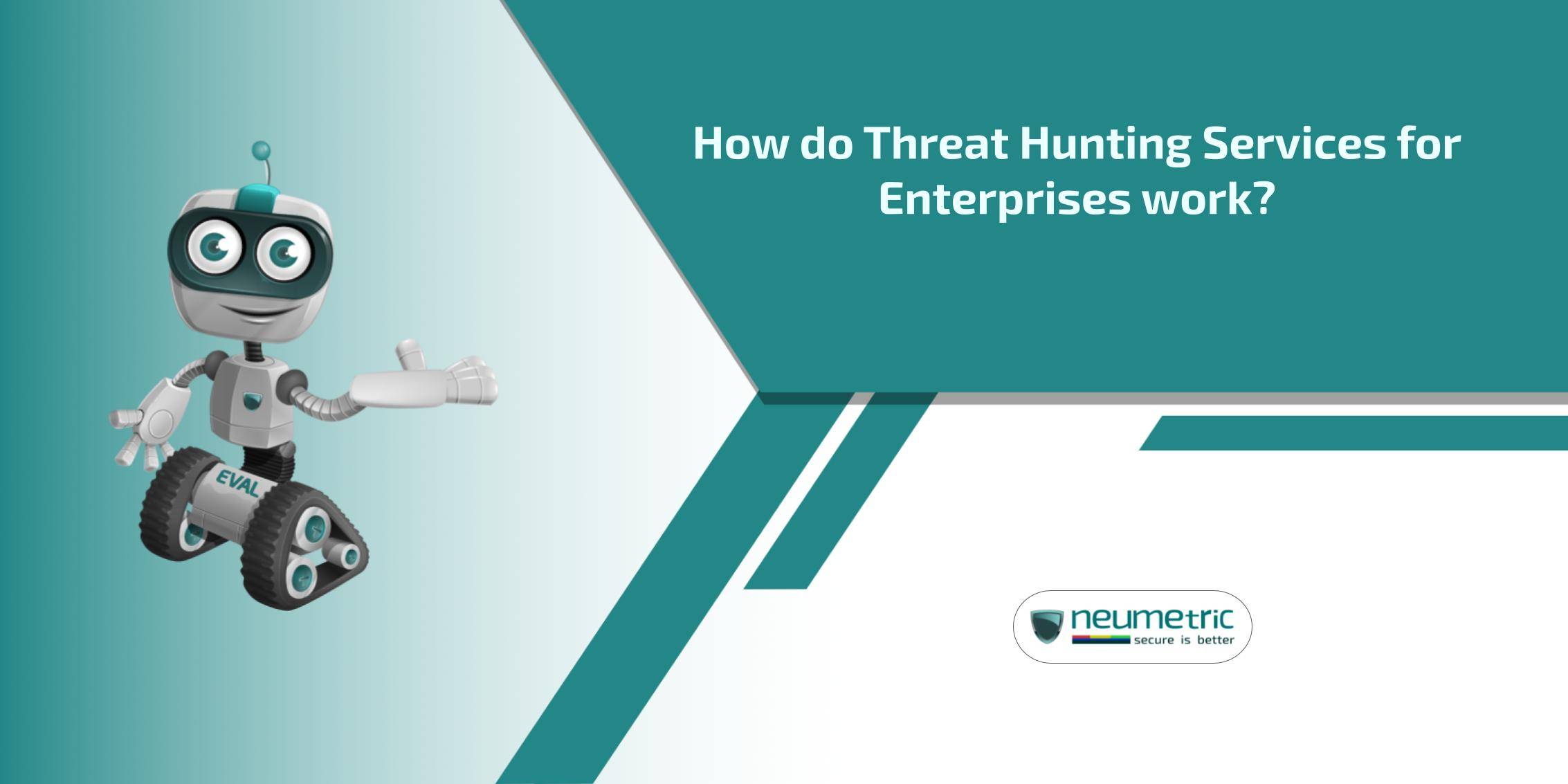Table of Contents
ToggleHow do Threat Hunting Services for Enterprises work?
Introduction
In the contemporary hyper-connected digital landscape, the urgency surrounding cybersecurity has reached unprecedented levels. With cyber threats continually advancing in sophistication, enterprises find themselves at the forefront of a constant struggle to safeguard their invaluable assets. This has led to an imperative need for proactive measures, giving rise to Threat Hunting Services as a pivotal line of defense. This exploration aims to dissect the intricacies of how these services function, offering insights into their operations & highlighting their role in fortifying enterprises against the ever-evolving landscape of cyber threats.
Within this dynamic context, Threat Hunting Services emerge as a critical ally in the relentless battle against cyber adversaries. As businesses grapple with the increasing complexity & diversity of cyber threats, the proactive nature of these services becomes paramount. By delving into the mechanisms & strategies employed by Threat Hunting Services, we aim to shed light on their crucial role in enhancing the resilience of enterprises & ensuring a robust defense against the evolving tactics of cyber adversaries.
Understanding the Landscape
The digital landscape has become increasingly precarious, with the escalation of cyber threats in both complexity & frequency. The financial toll these attacks impose on enterprises is staggering, thrusting cybersecurity into the forefront of organizational priorities. As a response to this growing menace, Threat Hunting Services have emerged as a proactive countermeasure, steering away from traditional reactive approaches. These services strategically harness the ever-evolving realm of threat intelligence, effectively adapting to the dynamic nature of cyber threats to maintain a vigilant edge.
In this challenging environment, Threat Hunting Services play a pivotal role in reshaping the cybersecurity paradigm. Their departure from reactive methodologies signifies a shift towards a more preemptive stance, where proactive measures take precedence. By embracing the fluid landscape of threat intelligence, these services establish themselves as a formidable line of defense, transcending the conventional role of reacting to cyber threats. Instead, they actively seek & neutralize potential risks before they materialize into attacks on enterprise systems, offering a proactive shield against the evolving cyber landscape.
The paradigm shift introduced by Threat Hunting Services reflects a commitment to staying ahead in the relentless battle against cyber threats. Their role extends beyond reacting to incidents, embodying a strategic approach that anticipates & mitigates potential risks, thereby enhancing the overall resilience of organizations in the face of dynamic cybersecurity challenges.
Core Components of Threat Hunting Services
The essence of Threat Hunting Services lies in the integration of core components that collectively construct a formidable defense mechanism. Comparable to a vigilant guardian, continuous monitoring stands as a fundamental element, engaging in real-time data collection & ensuring comprehensive visibility into network activities. This persistent surveillance acts as an early warning system, enabling proactive responses to potential threats before they escalate.
Another critical pillar of Threat Hunting Services is the integration of threat intelligence. Drawing from both external & internal sources, this component furnishes valuable insights into potential risks, allowing organizations to fortify their defenses with a nuanced understanding of the evolving threat landscape. Complementing this, behavioral analytics, enhanced by machine learning [ML] capabilities, assumes a pivotal role. By discerning anomalies & patterns in user & system behavior, this proactive approach ensures that Threat Hunting Services stay one step ahead, anticipating & mitigating potential threats before they can compromise the security of the enterprise.
Methodology Behind Threat Hunting
The methodology underpinning threat hunting represents a fundamental departure from the passive waiting game commonly associated with traditional cybersecurity approaches. It transforms cybersecurity from a reactive stance to an active pursuit of potential threats. This proactive methodology involves systematically seeking out & identifying indicators of compromise, ensuring that organizations are not merely responding to known threats but are actively anticipating & neutralizing potential risks before they can manifest into security incidents.
Crucial to this proactive approach is the emphasis on collaboration & communication within the organizational structure. Threat hunting recognizes the significance of interdepartmental coordination, fostering a cohesive effort among various facets of an organization. This collaborative ethos ensures that different teams work in tandem to proactively address potential threats. Furthermore, the sharing of threat intelligence emerges as a cornerstone of the threat hunting methodology. Establishing a network of shared insights & information enhances the collective ability of threat hunters to stay ahead of emerging threats, reinforcing the proactive nature of the overall strategy & fortifying the resilience of the cybersecurity framework.
In essence, threat hunting’s methodology not only involves the continuous & systematic search for hidden threats but also places a strong emphasis on a collaborative & communicative organizational culture. By actively sharing insights with the broader community, threat hunters contribute to a collective defense mechanism, reinforcing the proactive stance & collective resilience against the ever-evolving landscape of cyber threats.
Tools & Technologies
Threat Hunting Services wield a cutting-edge arsenal of tools & technologies designed to stay ahead in the ever-evolving landscape of cybersecurity. At the forefront, Advanced Security Information & Event Management [SIEM] systems play a crucial role by providing centralized log analysis & event correlation. These sophisticated systems enable Threat Hunting Services to discern patterns & anomalies across the network, enhancing their ability to identify potential threats swiftly. Additionally, Endpoint Detection & Response [EDR] solutions form a critical component, actively monitoring & responding to activities on endpoints. Employing isolation techniques when necessary, EDR solutions contribute to the rapid mitigation of potential threats, fortifying the overall security posture.
In tandem with SIEM & EDR, Threat Hunting Services leverage dedicated Threat Hunting Platforms, showcasing robust features & capabilities. These platforms seamlessly integrate into existing security infrastructures, enhancing the efficiency of threat detection & response efforts. The convergence of these tools empowers Threat Hunting Services to maintain a proactive stance, effectively navigating the complex digital landscape & securing enterprises against emerging cyber threats.
Challenges & Limitations
However, the human element emerges as a pervasive challenge within the domain of Threat Hunting Services. The imperative for skilled professionals & continuous training is undeniable, given that the effectiveness of these services heavily relies on human expertise. Striking a delicate balance between human-driven & automated threat hunting presents a significant challenge. While automation enhances efficiency, the nuanced understanding & intuition of human analysts remain irreplaceable in navigating the intricate landscape of cyber threats.
In addition to the human factor, privacy & ethical considerations introduce another layer of complexity. The careful calibration between ensuring robust security measures & respecting user privacy within legal & regulatory frameworks is an ongoing challenge. Navigating this delicate balance demands a meticulous approach to safeguarding sensitive information while actively pursuing potential threats. As Threat Hunting Services evolve, addressing these challenges becomes essential not only to maintain the integrity & effectiveness but also to uphold the ethical standing of cybersecurity practices.
Effectively addressing these challenges is pivotal for the continued evolution & success of Threat Hunting Services. The integration of human expertise with automation, coupled with a stringent commitment to privacy & ethical considerations, will be instrumental in shaping the future landscape of cybersecurity practices. As these services advance, a comprehensive approach that considers both technological capabilities & ethical standards will be essential for maintaining trust & ensuring the sustained effectiveness of Threat Hunting Services in the ever-changing cybersecurity landscape.
The Future of Threat Hunting Services for enterprises
As we confront an ever-evolving threat landscape, the trajectory of Threat Hunting Services is intimately linked to the imperative of staying ahead of emerging challenges. Central to their future is the pivotal role of anticipating & preparing for evolving threats, underscoring a continuous cycle of innovation in cybersecurity technologies. The forthcoming landscape of Threat Hunting Services is characterized by an unwavering commitment to continuous adaptation & enhancement. Enterprises, cognizant of the dynamic nature of cyber threats, find themselves compelled to invest significantly in cutting-edge technologies & methodologies. This investment empowers organizations to proactively outpace adversaries in the relentless & ever-shifting digital battleground.
The future of Threat Hunting Services rests on a proactive ethos, demanding a forward-looking approach to cybersecurity. This extends beyond the traditional paradigm of merely responding to existing threats; it involves actively anticipating & preparing for those on the horizon. The ongoing evolution of these services is intricately tied to their ability to embrace innovation, integrate advanced technologies & cultivate a resilient cybersecurity posture. This resilience is essential for effectively countering the increasingly sophisticated tactics employed by cyber adversaries. In navigating the complex & dynamic cybersecurity landscape, Threat Hunting Services become not only a reactive line of defense but also a strategic force capable of proactively mitigating emerging threats.
In essence, the future trajectory of Threat Hunting Services is marked by a dynamic interplay of continuous adaptation, technological innovation & a proactive mindset. As organizations invest in staying ahead of the curve, Threat Hunting Services are poised to play a central role in fortifying the cybersecurity posture of enterprises against the evolving tactics & challenges presented by cyber adversaries.
Conclusion
In summary, Threat Hunting Services play an indispensable role in fortifying enterprises against the pervasive & evolving threats in the digital realm. As the complexity of cyber threats continues to escalate, adopting a proactive security mindset becomes not only essential but a cornerstone in safeguarding invaluable assets. The intrinsic value of Threat Hunting Services lies not just in their reactive response to known threats but in their proactive pursuit of potential risks, embodying a continuous commitment to identifying & neutralizing threats before they can manifest.
Fostering collaboration across different departments, investing in the ongoing training & development of skilled professionals & staying abreast of technological advancements are pivotal steps in enhancing the effectiveness of Threat Hunting Services. Human expertise remains a linchpin in this dynamic landscape, harmonizing with cutting-edge technologies to create a robust defense mechanism. As organizations embark on the journey towards robust cybersecurity, Threat Hunting Services emerge as stalwart guardians, continuously adapting to the ever-shifting cyber landscape & embodying a commitment to the ongoing pursuit of a secure digital future.
Frequently Asked Questions [FAQ]
How do Threat Hunting Services differ from traditional cybersecurity measures?
Unlike traditional cybersecurity, Threat Hunting Services take a proactive stance. Rather than waiting for alarms to sound, they actively search for potential threats, identifying & neutralizing them before any damage occurs. It’s like having a cyber-sleuth on the lookout for trouble in the vast digital landscape.
Can you elaborate on the role of machine learning in the behavioral analytics of Threat Hunting Services?
Machine learning plays a pivotal role in behavioral analytics by enabling Threat Hunting Services to learn & adapt to evolving threats. It’s like having a virtual Sherlock Holmes that analyzes patterns & anomalies in user behavior, helping to distinguish between normal activities & potential security risks. This adaptive capability enhances the efficiency of threat detection.
What challenges do enterprises face in implementing Threat Hunting Services, especially regarding the human element?
One of the primary challenges is the need for skilled professionals. Think of it as assembling a skilled task force – they need to be well-trained & equipped to navigate the complex world of cybersecurity. Striking the right balance between human-driven & automated threat hunting is also a challenge, requiring a harmonious integration of expertise & technology.





